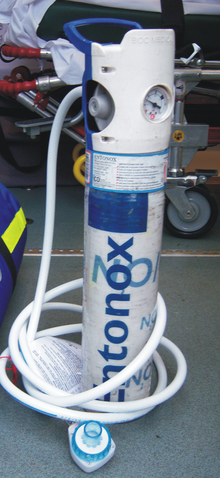Nitrous oxide (medication)

Entonox CD cylinder and giving set
|
|
| Clinical data | |
|---|---|
| Trade names | Entonox, others |
| ATC code | |
| Pharmacokinetic data | |
| Onset of action | 30 seconds |
| Duration of action | 1 minute |
| Identifiers | |
| CAS Number | |
| PubChem CID | |
| DrugBank | |
| ChemSpider | |
| UNII | |
| ChEBI | |
| ChEMBL | |
| Chemical and physical data | |
| Formula | N2O |
| Molar mass | 44.01 g·mol−1 |
| 3D model (Jmol) | |
|
|
|
|
Nitrous oxide, sold under the brandname Entonox among others, is an inhaled gas used as a pain medication and together with other medications for anesthesia. Common uses include during childbirth, following trauma, and as part of end of life care. Onset of effect is typically within half a minute and lasts for about a minute.
There are few side effects, other than vomiting, with short term use. With long term use anemia or numbness may occur. It should always be given with at least 21% oxygen. It is not recommended in people with a bowel obstruction or pneumothorax. Use in the early part of pregnancy is not recommended.Breastfeeding can occur following use.
Nitrous oxide was discovered between 1772 and 1793 and used for anesthesia in 1844. It is on the World Health Organization's List of Essential Medicines, the most effective and safe medicines needed in a health system. It often comes as a 50/50 mixture with oxygen. Devices with a demand valve are available for self-administration. The setup and maintenance is relatively expensive for developing countries.
Nitrous oxide (N2O) is itself active (does not require any changes in the body to become active), and so has an onset in roughly the lung–brain circulation time. This gives it a peak action 30 seconds after the start of administration; Entonox should thus be used accordingly, i.e. inhalation should start 30 seconds before a contraction becomes painful in labour. It is removed from the body unchanged via the lungs, and does not accumulate under normal conditions, explaining the rapid offset of around 60 seconds.
...
Wikipedia
